Model Engine Gallery Page 1
Click on the images to view them larger size.
This page contains a montage of engine pictures owned and in many cases, made by the Motor Boys and other sources. Click on the image to view it in larger size.
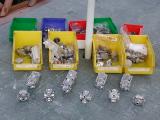
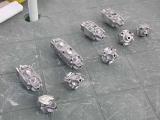
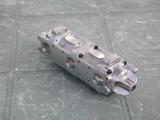
|
When Eric Offen (UK) decides to build some replicas, he obviously does not think small! Here are some pics of a work in progress he sent recently (8/00). The subject is Dan Calkin's famous "Elf" range of engines. Starting during the American "Great Depression", Calkin evolved a modular design that remained in production up to the beginning of the 1950's. His range included singles, twins, fours and a six (all multi cylinder being of a "flat" configuration).
The engines shared a common cylinder, although induction and piston details varied over the years. Induction varied also; initially side port, later reed valve. Eric's reproduction work is well along in the crankcase department. By my count, there are two singles, three twins, three fours and a six under way here. The flat areas on the fours and the six are for the reed valve assembly. Also note that the crankshaft on all engines follows "full size" practice with fore-aft journals. For the full story, see Eric's Elfs. In collectors circles, Elfs are rare and hence expensive. Casting kits are available from Mr Art DeKalb, 51 Van Alstyne Drive, Pulaski NY 13142. Like the originals, these are sand castings. I've heard these use original castings as the patterns, so are marginally smaller than original, but I could be wrong there as I've not bought a set yet. Art also supplies copies of the original drawings with his kits. |
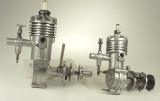
|
Here are two Hallam engines in Bert Striegler's collection, the Nipper and the Baby. Bert syas that the Nipper runs, but like the Little Britain (see below) it has a little less power than used by a fly's wings. The Baby is simply not made well enough to come to life, but it does have a very interesting two-piece piston with a shrunk-on steel skirt - that does not fit! |
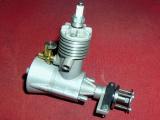
|
That Ken Croft bloke has been at it again between Morris Dances and produced this example of a 1.5cc Hallman Little Briton ignition engine from his own castings. Ken's pleased with this one, even though he reports that the skin on the rice pudding is in no danger whatsoever. |
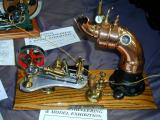
|
Ken Croft motored for an hour to attend the 2000 Harrogate Model Engineering Exhibition and returned with bargains and photos of some beautiful and unusual engines all built by Mr Dave Bramwell, a local clock and watch maker. Click on the thumb-nail pic opposite for a good time ;-) |

|
This engine was build by Vincent Chai. It was built from a materials kit designed by Andy Loftquist in the USA who runs a business called Metal Lathe Accessories (MLA's "Die Filer" kit is one of the many under my bench...) This was also Vincent's first attempt at engine building. He reports that it spins an APC 11x5 prop at 6300 rpm. I think the contrast in metals and beautiful finish really add charm to this engine, making it something Vincent must be proud of. |
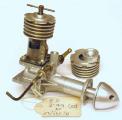
|
Another ED (Electronic Developments) engine picture from Ken Croft's collection; this one a 2.49cc imaginatively titled the "ED249". It is basically a front induction, bored out Competition Special (see Taplin Twin). The extra bits convert it from diesel to glow plug operation. The transfer passage cover on these cylinders is soft soldered in place. Quite ok for relatively low temperature diesel running, but I wonder how that held up when run as a glow? |
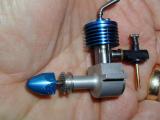
|
Looks like the infamous Clanford Clans came in more colors than red. This ble headed one was found at by Ken Croft at a British swap meet for a song (Folk song, Ken?). It is missing the tank, but displays the same high workmanship as Bert's example. Ken reports that like the red head Clan, his is beautifully made. The crankpin is pressed in, and it looks as though the crank disk is separate from the main shaft. It starts very easily and will run quickly, but it runs up to a peak then chokes itself down to a very rich run, then speeds up and the cycle repeats. Very Odd, says Ken. |

|
These next four shots were taken by Ken Croft at a show in the UK and show his quite understandable fascination with Dan Calkin's famous Elf series of engines (he called them "Elfs", never "Elves"). This one is his first engine, known as the "Corncob" for obvious reasons. There is an excellent, profusely illustrated, hard cover book available about the man and his engines. Drop an email to John Brown for pricing and delivery. |
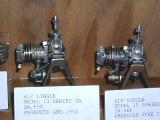
|
Following the "Corncob", Dan Calkin went on to a modular design that enabled him to share components across a range encompassing a conventional single cylinder plus 2, 4 and 6 cylinder, horizontally opposed engines. All this accomplished working from his parents house in Everett Street, Portland, Oregon during The Depression (when living in Portland I used to frequently drive that street and never knew the connection!) The Elf book shows the tooling he developed over the years to achieve this. |
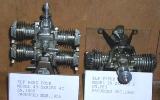
|
"Elf" engines were produced from the early 30's to the early 50's. At this time, Dan shut shop and went full time into the aerospace industry (he was a trained, professional engineer). During their production life, his multi-cylinder engines evolved from a side port design to reed valve induction. This shot shows the early side port induction twin on the right, with a reed valve 4 on the left. All engines employed sand castings using methods Dan kept secret. |
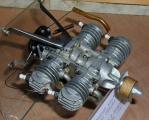
|
This engine may be considered as close to the pinnacle of the Elf range; only the flat 6 is more impressive. One feature of all the Elf engines is the crankshaft and conrod design. Even the singles had a full throw crank with shaft protruding front and rear. The conrod used a stamped bronze strap on the big end. The Elf book shows the tools made to mass produce the rods and strap. Thanks Ken for taking these great pics! |
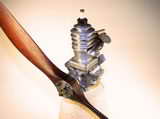
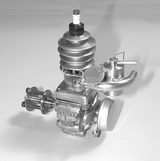
|
Both Roger Schroeder and Bert Striegler have made Elf Corncob replicas. I'm even tempted myself. This shot is of Bert's replica. Not so obvious here is the fact that the engine is fitted with an actual float-bowl carburettor, designed to be gravity fed from the fuel tank. The timer is described as a "demented nightmare of teensy weensy parts", but it all works! Like the later Elf engines, the Corncob features a vertically split crankcase and full throw crankshaft. The cylinder liner was made from steel tube, pressed into the head casting.
Bert's prop of is carved from walnut, exactly per the plan in the Calkin book mentioned above. The Elf ad claimed the Corncob would turn that prop 3,400 RPM, and oddly, Bert says, that is exactly what his example does! For trivia buffs, the Corncob appeared in Ripley's Believe It Or Not back in about 1934 as the smallest engine in the world! Bert says his replica (from castings by Motor Boy Don McClusky) starts and runs easily. |


|
Here's an engine with some remarkable history that I'm too scared to disclose on the open Internet for fear of a financial and perhaps physical knee-capping! The engine pictured is a 0.2cc Clanford Clan 1 from the collection of Mr Bert Streigler. It looks great and the workmanship is superb. It does not run. |

|
It's remarkable how many engine builders started with one of Lawerence Sparey's designs. Among the Motor Boys, Bert, David, Ken and I all share this characteristic - even if the period of time involved covers a decade, or two. So I though it might be nice to feature some "first efforts", starting with Bert Striegler's 5cc Sparey. Bert made this engine to power a R/C version of the venerable Keil Kraft Junior 60, hence the Perry Carb, and reports that it's the one of the smoothest throttled engines he's ever owned - ticking over at just 300 RPM at idle. |
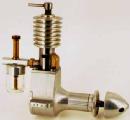
|
..and here is Ken Croft's third engine building effort, a 0.8cc (sic) Sparey. Actually, this engine is closer to 0.6cc, but is universally known as a 0.8cc! The engine appeared in Model Mechanic Dec/Jan, 1947, while the 5cc version was published in Aeromodeller circa 1946 and reprinted in Laidlaw-Dickson's book Model Diesel Engines. |
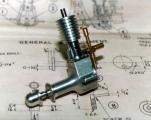
|
..and here is my own first engine building attempt on the small Sparey. The little fella' started right away, but the skin on the rice pudding, as they say, is in no danger. Still, there is nothing like the thrill of having your first engine actually start and run - performance is secondary. My engine was from a casting and materials kit supplied by Woking Precision Models (UK). You can find their adds in just about every issue of Model Engineer. |
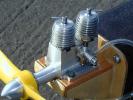
|
Isn't this an absolute jewel? Ken Croft sent this shot taken at a Sunday flying session at RAF Church Fenton in the UK. The engine is (obviously) a twin Mills - one of only three made by Derek Giles. I was about to write that Derek makes Mills replicas, but most of the engines he produces are in sizes (and configurations) never offered my Mills themselves, so let's say Derek produces original, unique engines of his own design in the "Mills Tradition". For some more of his work is in Bert Striegler's collection. |
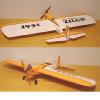
|
How many of us have made a model of some model we made as a kid that marked some kind of milestone - like the one we learnt to fly U/C with (or C/L, depending on your locality)? Now the re-make is probably sprayed, while the original would be brushed, etc, but memory plays funny tricks. Here is a Wee Duper Zilch made by Tim Dannels to mimic the one he learnt to fly with. How Tim manages to find the time to do lovely work like this and still get ECJ out is a wonder by itself. Aside: my nostalgia wall hanging is a Kiel Kraft Demon with an ED Racer, though the original had a Taipan 1.5cc. If I had the room, I'd add Junior 60 to the collection.. *sigh*. |
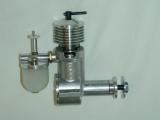
|
This is the project that is keeping David Owen off the streets and putting his kids through college (if only!) It represents a collaboration between David and Australian model engine legend, Gordon Burford, to produce a limited edition collectors version of Gordon's first commercial offering, the GB5CC. Loosely based on the Sparey 5cc diesel from 1947, this engine has been upgraded in many details while preserving the appearance. Contact David is you want to reserve one now - they won't last! |
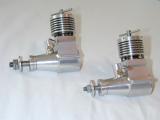
|
Here's two examples of the Owen "Mate" 2cc diesel, side by side. One was built my me and the other by David. His has recently returned from noted English engine analyst Peter Chinn. The engines are unusual in that they utilize an aluminum extrusion for the crankcase. Can you pick which one is which? (Clue - David is fully metric literate, I'm not). |
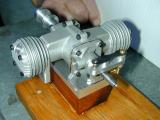
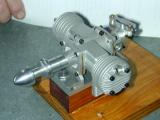
|
Craftsman Twin under construction by Russell Watson-Will of Brisbane, Australia. A man of infinite patience, Russ made four crankshafts and four timers arriving at ones he was finally happy with (now that's a Craftsman!). He assures me that the gaskets visible in these shots are a temporary measure for initial testing purposes. |

|
This little demonstration of how the location of the knurl wheel controls the pattern when plunge knurling porp drive washers was prepared by Bert Striegler. I think Bert's shot just about says it all. I'll just add that the best results are obtained when the knurl is angled slightly so it cuts shallower towards the center of the job. |
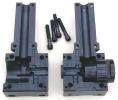
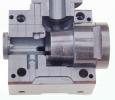

|
When the Empire Motor Boy (Ken Croft) decides to make himself a replica, he makes a capital "R" Replica! Here we see his Cyclone and the dies he made to cast the crankcase. This was Ken's first attempt at making a perm-mold (gravity die-cast) casting. Outstanding!
Tim Dannels (Grand Fromage of the Model Museum) was heard mumbling about what guys like Ken do to his job as a historian when trying to identify one-off amateur built engines and obvious, commercial, short production run engines. |

|
When Roger Schroeder is not making castings in his basement, he enjoys some unusual flying subjects. Here is his Rubber powered, R/C Taylor Craft (which he insists he flies with some Latin guy named "Manual Pulse"). Roger, never afraid of controversy, believes our beloved gas engines are on the decline and that CO2, compressed air and electric will be the wave of the future due to noise. Hate to admit it, but I think he may be right. As a last gasp, Russ Watson-Will intends to bring in the new millennium by firing up a pulse jet in this back yard and to hell with the consequences! |

|
Isn't that a beauty?! The engine is a Trojan Jr, one of the Motor Boys plans and this example was made by Bert Streigler. The cylinder is finished with "Rustoleum Sunrise Red" which Bert tells us takes a long time to cure fully, but should stand up ok to the heat of running. Bert made his with a bronze bushing. The original uses dual roller bearings, which would really require a hardened shaft. |